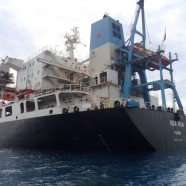The end of the Probo Koala
The Hua Wen, ex-Probo Koala is going to be demolished in the coming weeks in China. From August 2006 on, the scattering in Abidjan of desulphurization waste containing mercaptan and hydrogen sulphide has provoked a panic and the paralysis of Ivory Coast business capital. 16 fatalities were officially reported; the victims had been exposed to the toxic emanations. The toxic and stinky waste which had been unloaded from the Probo Koala slop tanks had illegally left Amsterdam and Tallinn, two North European ports (1).
The end of the Probo Koala
The Hua Wen, ex-Probo Koala is going to be demolished in the coming weeks in China. From August 2006 on, the scattering in Abidjan of desulphurization waste containing mercaptan and hydrogen sulphide has provoked a panic and the paralysis of Ivory Coast business capital. 16 fatalities were officially reported; the victims had been exposed to the toxic emanations. The toxic and stinky waste which had been unloaded from the Probo Koala slop tanks had illegally left Amsterdam and Tallinn, two North European ports (1).
The end of the Probo Koala
The Hua Wen, ex-Probo Koala is going to be demolished in the coming weeks in China. From August 2006 on, the scattering in Abidjan of desulphurization waste containing mercaptan and hydrogen sulphide has provoked a panic and the paralysis of Ivory Coast business capital. 16 fatalities were officially reported; the victims had been exposed to the toxic emanations. The toxic and stinky waste which had been unloaded from the Probo Koala slop tanks had illegally left Amsterdam and Tallinn, two North European ports (1).
Polar Bears: Left Out in the Cold
The polar bear (Ursus maritimus) is a marine mammal that lives off of the other marine mammals inhabiting the artic ice pack, and the surrounding ice flows and ocean. The polar bear is thus an excellent swimmer. The artic ice pack, home of the polar bear, is disappearing. The vulnerability and mortal risks faced by polar bears are increasing.
The polar bear, beloved by many, has become the martyr employed by governments and NGOs to symbolize the fight against global warming. It has become a fundraising symbol and a top-model.
Polar Bears: Left Out in the Cold
The polar bear (Ursus maritimus) is a marine mammal that lives off of the other marine mammals inhabiting the artic ice pack, and the surrounding ice flows and ocean. The polar bear is thus an excellent swimmer. The artic ice pack, home of the polar bear, is disappearing. The vulnerability and mortal risks faced by polar bears are increasing.
The polar bear, beloved by many, has become the martyr employed by governments and NGOs to symbolize the fight against global warming. It has become a fundraising symbol and a top-model.










